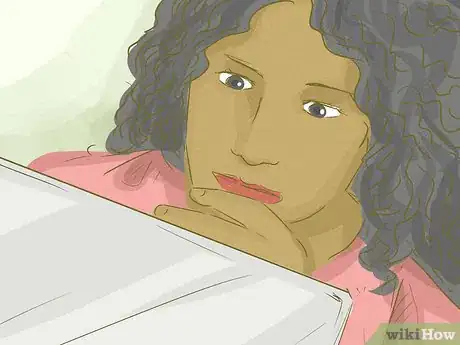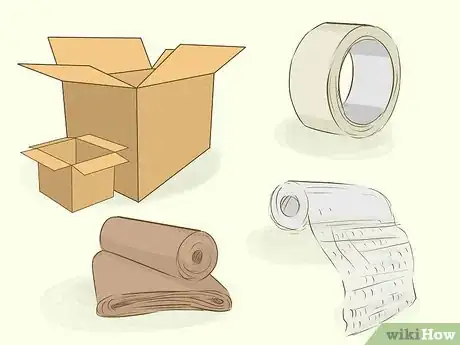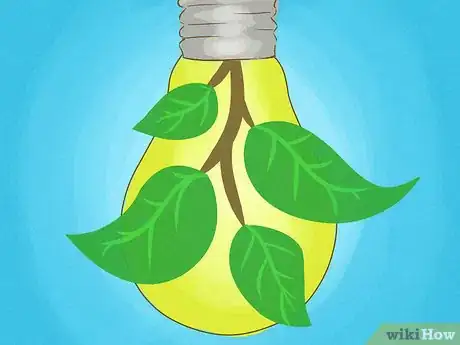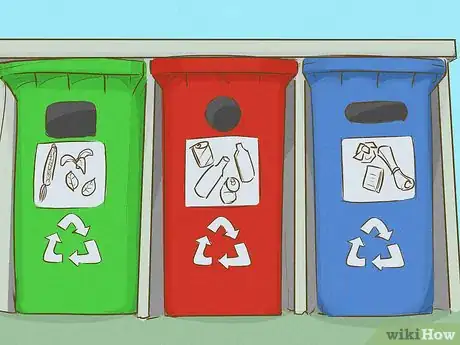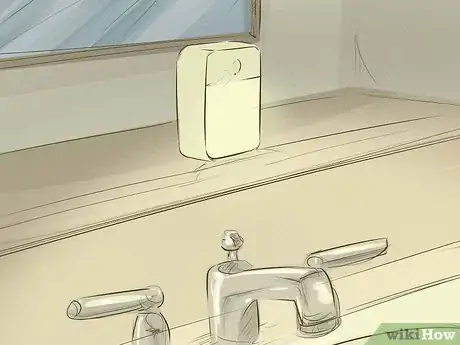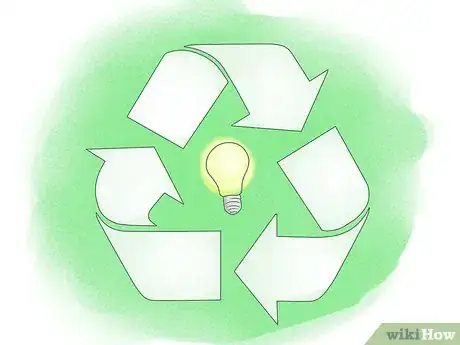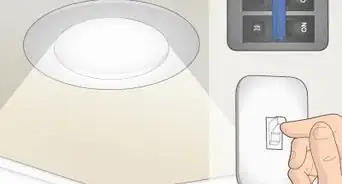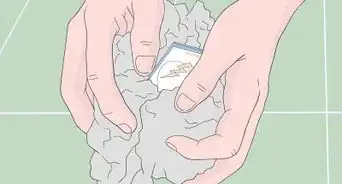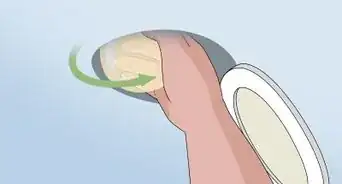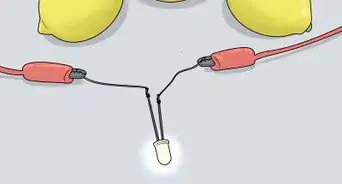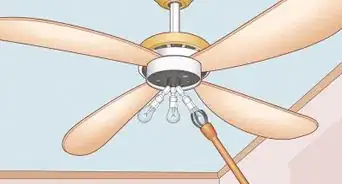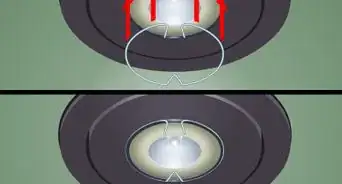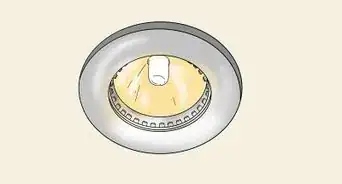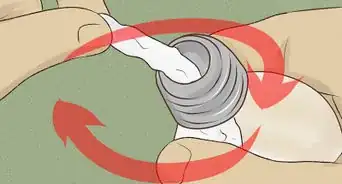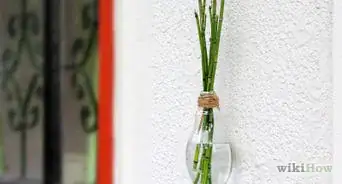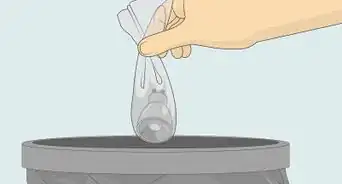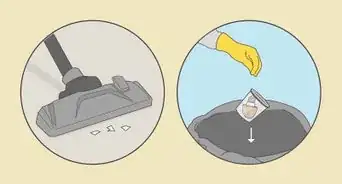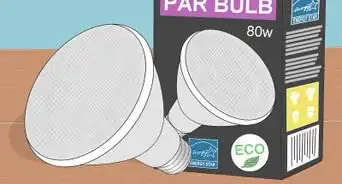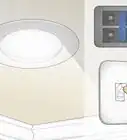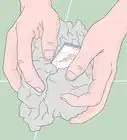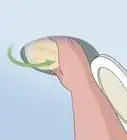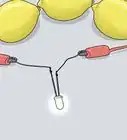This article was co-authored by Marvin Woo. Marvin Woo is a licensed electrician and the Owner of Woo's Electrical & Appliance based in East O’ahu. With over two decades of experience, he specializes in troubleshooting issues and maintaining residential electrical systems. Marvin is both licensed and insured to complete electrical work in the state of Hawaii.
There are 10 references cited in this article, which can be found at the bottom of the page.
This article has been viewed 47,995 times.
You've just put in your new lightbulb, but what do you do with the old, burnt out one? Check with your local garbage or recycling center to see if it is illegal to throw away fluorescent bulbs in your area. Recycle your bulbs when you can, and cover non-recyclable bulbs like incandescent in cardboard or a paper bag before you put them in the trash. If you are unsure of what type of light you have, look at the information stamped on the base above the threading of the bulb.
Steps
Disposing of Fluorescents and CFLs
-
1Check your local laws. These bulbs contain mercury, which is toxic, so many places have laws against disposing of them in the trash. Check with your local garbage and recycling center to see if it is ok to dispose of fluorescents and CFLs in the trash.[1]
- In the US, the states of California, Maine, Massachusetts, Minnesota, New Hampshire, Vermont, and Washington all prohibit throwing away fluorescents and CFLs.[2]
- Even if your country, state, or province does not have laws against disposing of fluorescent lights, your regional or town authorities may. Always check with your local center to get the most accurate laws for your area.
-
2Throw away fluorescents only if it is legal. If it is legal to throw away fluorescent lights and CFLs in your area, you can put them in the trash. Be sure to wrap them in their original packaging or a paper bag before disposing of them.[3]Advertisement
-
3Recycle your fluorescent lights if your area has proper facilities. CFLs and fluorescent lights can be recycled.[4] In most areas, there are a number of options for dealing with these types of lights:[5]
- Check with your local waste authority to see if you have a nearby drop-off location.
- Check with the store where you purchased the bulbs. Large retailers such as IKEA and Home Depot often offer recycling for lights you purchased through them.[6] [7]
- Check with your local waste authority or a website such as Earth911.com or RecycleABulb.com to see if they offer curbside pickup in your area or local drop-off areas.
-
4Put broken bulbs in a sealable container. If you break a fluorescent tube or CFL while changing it, shut off any forced air or heat system that you have and allow the room to air out for ten minutes. Keep all people and pets out of the room for that time. Then, clean up the bulb and recycle or dispose of it:[8]
- Scoop up as much of the broken bulb and powder as possible using cardboard or stiff paper.
- Clean up any additional remains and small fragments with duct tape. Do not vacuum until all powder has been cleaned up.
- Seal the powder and glass in a sealable container such as a glass jar and dispose of it as appropriate through your local channels.
Getting Rid of Traditional Bulbs
-
1Throw away incandescent bulbs. Since incandescent bulbs do not contain toxic materials, they are typically fine to simply throw in the trash. The thin bulb glass is typically fragile, though, so many people suggest putting the bulb back in its original packaging to keep it from shattering.[9] [10]
- If you do not still have the original packaging, you can wrap the bulb in an old plastic or paper grocery bag.
-
2Repurpose incandescent bulbs if you don't want to trash them. As long as your bulb is not cracked or exploded, you can also reuse incandescent bulbs in crafts or household projects. There are a number of tutorials online for project including lightbulb vases, terrariums, and even seasonal ornaments.[11]
- Lightbulb crafts typically require a screwdriver and needle nose pliers to take out the filament.
- Protective gloves are also recommended to keep your hands safe in case of shattering glass.
-
3Put halogen bulbs in the trash. Like incandescent bulbs, halogen bulbs don't contain toxic materials, so they can go directly in the trash. If you have the original packaging, you can put the light back in it. Halogens are typically a bit more durable than incandescents, though, so you don't always need to cover them before throwing them away.[12]
Dealing with LED Bulbs
-
1Throw away LED bulbs. Like CFLs, LED bulbs are low-heat and energy efficient. Unlike CFLs, though, they don't contain mercury, so they can be disposed of directly in the trash. If you have the option to recycle LED bulbs, though, that is often preferable since they contain many recyclable materials.[13] [14]
-
2Recycle LED bulbs as an environmentally friendly alternative. LED bulbs are easy to recycle in many places. Most countries don't have any national standard or program for recycling LEDs, but many local recycling centers are willing to take them. Call your local recycling center to see if they have a program for LED bulbs.[15]
- Some big box hardware stores may also have drop-off spots for your old bulbs.[16]
-
3Recycle holiday lights through the mail. Holiday lights are some of the easiest LEDs to recycle. Many areas have programs where you can even send bulbs in at no charge through the mail. Look online to see if there is a holiday bulb recycling option available in your area.[17]
- Sites like HolidayLEDs.com are a good place to start checking for holiday light recycling in your area.[18]
Bulb Types
- Compact fluorescent lightbulbs (CFLs): Compact fluorescent bulbs screw into standard light sockets, and usually have a twisted white tube about 1/2" in diameter.
- Incandescent bulbs: These are standard lightbulbs. They're typically inexpensive and readily available. They have a filament wire in the middle, screw into standard light sockets, and come in clear and frosted finishes.
- LED Bulbs: LED lightbulbs are long-lasting, have no filament wire, and can fit into regular light sockets.
References
- ↑ https://www.epa.gov/cfl/recycling-and-disposal-cfls
- ↑ https://sfenvironment.org/light-bulb-disposal-in-sf
- ↑ https://ocrra.org/resources/fluorescent-bulbs/
- ↑ Marvin Woo. Licensed Electrician. Expert Interview. 1 December 2021.
- ↑ https://www.epa.gov/cfl/recycling-and-disposal-cfls
- ↑ https://ocrra.org/resources/fluorescent-bulbs/
- ↑ Marvin Woo. Licensed Electrician. Expert Interview. 1 December 2021.
- ↑ https://www.epa.gov/cfl/cleaning-broken-cfl
- ↑ https://www.denvergov.org/content/denvergov/en/trash-and-recycling/recycling/recycling-directory-dropoff-locations.html#!rc-cpage=41207
- ↑ Marvin Woo. Licensed Electrician. Expert Interview. 1 December 2021.
- ↑ https://www.houselogic.com/organize-maintain/storage-ideas-hacks/light-bulb-crafts/
- ↑ https://www2.montgomerycountymd.gov/DepHowDoI/material.aspx?tag=lights&material_key=29
- ↑ https://recyclenation.com/2015/01/how-to-recycle-light-bulbs/
- ↑ Marvin Woo. Licensed Electrician. Expert Interview. 1 December 2021.
- ↑ https://recyclenation.com/2015/01/how-to-recycle-light-bulbs/
- ↑ Marvin Woo. Licensed Electrician. Expert Interview. 1 December 2021.
- ↑ https://recyclenation.com/2015/01/how-to-recycle-light-bulbs/
- ↑ https://holidayleds.com
About This Article
If you're unsure how to dispose of an incandescent lightbulb, put it back in its box so it doesn't shatter before throwing it in the trash. Alternatively, try and find a craft project to reuse your bulbs in if you don't want to put them in the trash. When dealing with fluorescent bulbs, try to recycle them to prevent mercury, which is a toxic material, from getting into the trash. However, you can place them in a box before throwing them out if it's legal to do so in your area. To learn how to dispose of LED bulbs, including holiday lights, keep reading!
